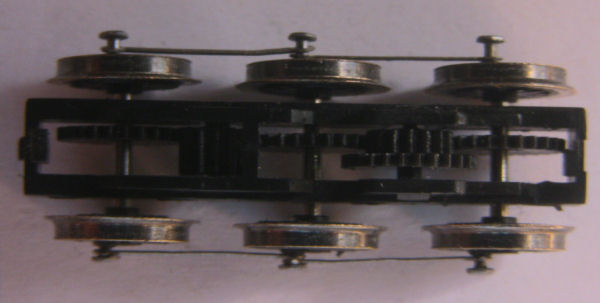At our group meeting on Saturday Nigel kindly turned the wheels of the Terrier down to finescale standards.
There wasn't much to come off but the result is certainly worth it.
You can see from the above picture how flimsy the Dapol coupling rods are! The chassis is fully geared so the rods just go along for the ride which was lucky because the Dapol wheels slipped on their axles during the above process and needed re-quartering. In this case it is sufficient to get them close enough.
As well as straightening the coupling rods (again) I also need to reduce the height of the crank pins on one side which you will see refused to go in to the wheel as much as they did on the other side. Getting the pins in was difficult until Guy showed me a trick for holding small items using double sided tape stuck to the end of a pointed object.
When set to 9.42mm gauge the wheels just foul the plastic brake rods which will need to be filed, but only a little as they do a good job of keeping the wheels central without having to add any washers.
It looks as if the body will escape without any surgery. I have reassembled the chassis and found it impossible so far to get the front pickups in contact with the wheels - it is necessary to spring them out of the way when re-fitting the wheels and this is enough to make them lose contact. I will have to think about this...
I have also added a chip (CT DCX74z) which, although it replaced the resistor board, now intrudes quite noticeably into the cab. I may have a go at re-soldering the wires to the motor in a neater fashion which may save me a bit of space.




Richard, how are you getting on with this? Nigel has done the wheels on Stepney and I'm now trying to get it to run nicely on my layout. It's a bit lurchy at the moment and jumps off a couple of turnouts that my other two 0-6-0s go through OK. Can't see why this should be happening. Measures taken so far:
1. I've snipped the brake rods off because they were fouling the crankpins and looked too visually clunky to me anyway. The two front crankpins were also just clipping the steps but taking a tiny slither of plastic off the front edge of each step fixed that. Nothing else is rubbing on anything.
2. The quartering was a tiny bit out, easy to correct by feel. Now runs very freely with the motor disengaged but I'm not convinced it will stay put without some glue.
3. Have checked the back-to-back and it's fine.
4. I'm also having a lot of trouble with the pickups which in my case are nowhere near at least two of the wheels. In addition they seem to be within a gnat's of touching the underside of the metal motor body and causing a short. Does your motor have anything underneath it to provide some insulation? Maybe poor pickup is making the loco lose power through the turnouts and jump off when it makes contact again. Any genius ideas on sorting those pickups out would be apreciated.
Cute little things though, aren't they!
Comment by pbeech — 7 May 2009 @ 11:08 pm
Update to my first comment.
1. The brake rods aren't needed to prevent excessive side-to-side play on the axles. Neither are washers, as the driving gear on each axle runs in a slot that limts the amount of play.
2. Once a wheel has been disturbed on its axle, the quartering doesn't stay put without glue. I know you found this too. I'm going to try using a tiny spot of epxoy on the end of each axle, with a little notch in the wheel centre to provide a key, rather than pull the wheels off again.
3. I've eased the back to back a fraction and Stepney is now running through my tightest turnouts without jumping off.
4. You said on the phone that your Terrier ran very badly when the the front pickups weren't making good contact and I found the same with mine. I made up three 'tweezers' out of thin brass sheet to pinch the pickups in while the wheel set was dropped in and they sort of worked, although it still took some poking about with a pin the get the front pickups in the right place. Getting some current throught the front wheels transformed the slow running.
5. The three driving gears protrude so far below the chassis that they will foul anything between the rails that is not below rail level. In my case the culprit was a sleeper crossing that I'd set level with the rail tops, fine for my other locos but Stepney wouldn't go over it.
Anyway, runing nicely now considering lack of DCC and how light the loco is. Let's hope it stays that way.
Comment by pbeech — 9 May 2009 @ 8:41 am